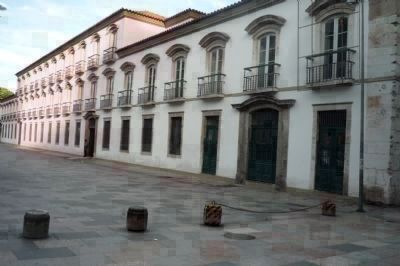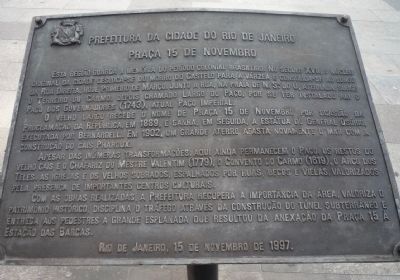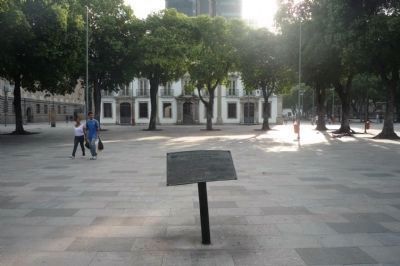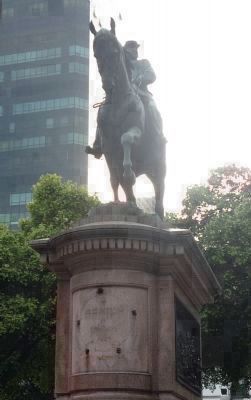Centro in Rio de Janeiro, Brazil — Southeast Region (Coastal)
Praça 15 de Novembro
Prefeitura da Cidade do Rio De Janeiro
Esta região guarda a memória do período colonial Brasileiro. No Século XVII, o núcleo original da cidade desloca-se do morro do Castelo para a várzea e consolida-se ao longo da Rua Direita, hoje Primeiro de Março. Junto à rua, na praia de N.S. do Ó, aterrado surge o Terreiro do Carmo, depois chamado Largo do Paço, por se ter instalado ali o Paço dos Governadores (1743), atual Paço Imperial.
O velho largo recebe o nome de Praça 15 de Novembro por ocasião da Proclamação da República em 1889, e ganha, em seguida, a estátua do General Osório, executada por Bernardelli. Em 1902, um grande aterro afasta novamente o mar com a construção do cais Pharoux.
Apesar das inúmeras transformações, aqui ainda permanecem o Paço, os restus do velho cais e o Chafariz do Mestre Valentim (1779), o Convento do Carmo (1619), o Arco dos Teles, as igejas e os velhos sobrados, espalhdos por ruas, becos e vielas, valorizados pela presença de importantes centros culturais.
Com as obras realizadas, a Prefeitura recupera a importãncia da área, valoriza o trimõnio histórico, disciplina o tráfego através da construção do túnel subterráneo entrega aos pedestres a grande esplanada que resultou da anexação da Praça 15 á Estação das Barcas.
Rio de Janeiro, 15 de Novembro de 1997.
[English Translation:]
Prefecture of Rio De Janeiro
15th of November Square
This area preserves the memory of the Brazilian colonial period. In the 17th Century, the original nucleus of the city moved from Castelo Hill to the fertile lowland valley and consolidated along Direita Road, today’s First of March Road. Next to the street, on the earth-filled beach of Nossa Senhora do Ó, appeared Carmo Square, later called the Palace Square, as installed there was the Palace of the Governors (1743), currently, the Imperial Palace.
The old plaza received the name 15th of November after the Proclamation of the Republic in 1889, and received, after that, the statue of General Osório, executed for Bernardelli. In 1902, a large landfill and construction of the Pharoux Quay again moved the sea away.
Despite the many changes, here are still the Palace, the restus, the old pier and the Mestre Valentim Fountain (1779), the Carmelite Convent (1619), the Arco dos Teles , the churches and old mansions, scattered streets and alleys, and important cultural centers.
With the work finished, the City government restores the importance of the area, enhances the historical values, manages traffic through the construction of the underground tunnel, and delivers to pedestrians the great esplanade resulting from annexation of 15th of November Square and the Ships’ Station
[the terminus for commuter boats serving communities around Guanabara Bay].
Erected 1997 by Prefeitura da Cidade do Rio De Janeiro.
Topics. This historical marker is listed in these topic lists: Colonial Era • Waterways & Vessels. A significant historical year for this entry is 1889.
Location. 22° 54.185′ S, 43° 10.411′ W. Marker is in Rio de Janeiro. It is in Centro. Marker is on the Plaza of 15 November just west of Avenida Alfred Agache. Touch for map. Marker is at or near this postal address: Praça Quinze de Novembro 155, Rio de Janeiro 20010, Brazil. Touch for directions.
Other nearby markers. At least 8 other markers are within 10 kilometers of this marker, measured as the crow flies. João Cândido Felisberto Memorial (about 120 meters away, measured in a direct line); Ordem Terceira do Carmo Church (about 180 meters away); Christ the Redeemer Monument (approx. 4.9 kilometers away); CCAPA (approx. 5.4 kilometers away); Cristovão Leite de Castro (approx. 5.4 kilometers away); Augusto Ferreira Ramos (approx. 5.4 kilometers away); APA das Pontas de Copacabana e Arpoador (approx. 9.4 kilometers away); Copacabana Fort (approx. 9.4 kilometers away). Touch for a list and map of all markers in Rio de Janeiro.
Also see . . .
1. República Velha. On November 15, 1889, Marshal Deodoro da Fonseca deposed Emperor Dom Pedro II, declared Brazil a

Photographed By Richard E. Miller, December 12, 2009
3. The old Imperial Palace, now Rio's Centro Cultural
- built as the residence for governors of colonial Brazil and later used by King João VI of Portugal and the rulers of the Empire of Brazil, Pedro I and Pedro II. One of the main political centers of Brazil from 1743 to 1889, when Brazil was elevated to the status of Kingdom in 1815 (the Portuguese state officially becoming the United Kingdom of Portugal, Brazil and the Algarves) the capital was transferred here from Lisbon - the only instance of a European country being ruled from one of its colonies.
2. Praça 15 Colonial Rio Walking Tour. (Submitted on January 9, 2010, by Richard E. Miller of Oxon Hill, Maryland.)
3. John VI of Portugal. King of the United Kingdom of Portugal, Brazil and the Algarves (later changed to just King of Portugal and the Algarves, after Brazil was recognized independent in 1825). (Submitted on January 9, 2010, by Richard E. Miller of Oxon Hill, Maryland.)
4. Manuel Luís Osório. (Submitted on January 9, 2010, by Richard E. Miller of Oxon Hill, Maryland.)
5. Wikipedia entry for Rio de Janeiro. (Submitted on June 13, 2010, by Richard E. Miller of Oxon Hill, Maryland.)
Additional keywords. Reino Unido de Portugal, Brasil e Algarves ; Praça XV; War of the Triple Alliance; República Velha (Old Republic); Deodoro da Fonseca.
Credits. This page was last revised on January 31, 2023. It was originally submitted on January 9, 2010, by Richard E. Miller of Oxon Hill, Maryland. This page has been viewed 1,912 times since then and 6 times this year. Photos: 1, 2, 3, 4, 5. submitted on January 9, 2010, by Richard E. Miller of Oxon Hill, Maryland. • Bill Pfingsten was the editor who published this page.



![João [John] VI of Portugal - statue in Praça 15 de Novembro:. Click for full size. João [John] VI of Portugal - statue in Praça 15 de Novembro: image. Click for full size.](Photos/92/Photo92223.jpg?11252005)